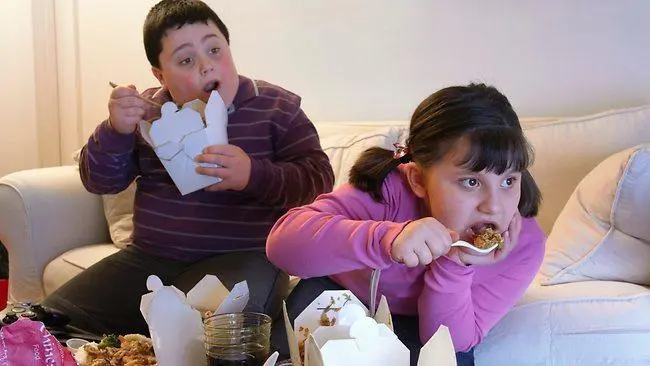Obesity has been a growing concern in the United States for several decades, and the latest research indicates that the problem is becoming even more prevalent among young children.
A new study published in the journal Pediatrics has revealed that severe obesity is on the rise among preschool-aged children, contradicting previous findings that suggested a decline in obesity rates among this demographic.
The study, conducted by researchers at the U.S. Centers for Disease Control and Prevention, focused on children participating in a government food program.
Previous research had indicated a slight decrease in obesity rates among these children about a decade ago, offering hope that efforts to combat childhood obesity were making a difference.
However, the latest update shows that the rate of severe obesity has actually increased, indicating a troubling reversal in the positive trend that had been observed.
According to the study, approximately 2.5% of all preschool-aged children were classified as severely obese during the period under investigation.
This finding is consistent with national data that suggests a similar increase in severe obesity rates among young children.
Heidi Blanck, one of the study’s authors, expressed dismay at the results, stating, “We were doing well and now we see this upward trend.”
The implications of this trend are significant and far-reaching. Severe obesity in childhood is associated with a range of health problems, including an increased risk of developing chronic conditions such as diabetes, heart disease, and certain types of cancer.
Additionally, children who are severely obese may experience social and emotional challenges, as well as discrimination and stigmatization.
The factors contributing to the rise in severe obesity among young children are complex and multifaceted.
A combination of genetic, environmental, and behavioral factors are thought to play a role in the development of obesity at a young age.
Access to healthy, nutritious foods, opportunities for physical activity, and education about healthy lifestyle choices are all important components of efforts to prevent and address childhood obesity.
It is clear that urgent action is needed to address the growing problem of severe obesity among young children.
Public health initiatives, community-based programs, and policy changes are all essential components of a comprehensive approach to tackling childhood obesity.
Efforts to promote healthy eating habits, increase access to nutritious foods, and encourage physical activity must be prioritized in order to reverse the current trend and improve the health and well-being of young children.
In conclusion, the latest study on severe obesity among young U.S. children highlights a concerning trend that demands attention and action.
The increase in severe obesity rates among preschool-aged children is a cause for alarm, and efforts to address this issue must be intensified.
By working together to promote healthy lifestyles and provide support for families, communities, and healthcare providers, we can make a positive impact on the health of our youngest generation and create a brighter, healthier future for all.
A recent study conducted on children aged 2 to 4 years who were enrolled in the Women, Infants and Children (WIC) program has revealed some concerning findings.
The WIC program provides healthy foods and other services to preschool-aged children from low-income families. The study involved weighing and measuring the children to determine their body mass index (BMI).
The results showed that in 2010, 2.1% of the children in the program were severely obese. However, this rate decreased to 1.8% six years later. Unfortunately, by 2020, the rate had increased to 2%, which equates to approximately 33,000 children out of over 1.6 million enrolled in the WIC program.
The study also identified significant increases in severe obesity rates in 20 states, with California having the highest rate at 2.8%.

Additionally, there were notable rises in some racial and ethnic groups, with the highest rate of severe obesity (2.8%) being observed in Hispanic children.
These findings are particularly concerning as experts suggest that severe obesity at such a young age is almost irreversible and is strongly associated with chronic health problems and premature death.
The results of this study highlight the importance of addressing childhood obesity, particularly in low-income families. It is imperative that measures are taken to prevent and manage severe obesity in young children to avoid long-term health consequences.
The WIC program, which provides healthy foods and other services to low-income families, has the potential to play a significant role in addressing childhood obesity.
However, further research is needed to determine the most effective strategies to prevent and manage severe obesity in young children, particularly in disadvantaged communities.
Childhood obesity rates have been on the rise in the United States, and it is not clear why. According to a recent study, the obesity rates among children who participate in the Women, Infants, and Children (WIC) program have increased over the past decade.
This is concerning, as the WIC program is designed to provide nutritious foods to low-income families with young children.
In the past, when WIC obesity rates dropped, experts attributed it to policy changes that eliminated juice from infant food packages, provided less saturated fat, and made it easier to buy fruits and vegetables.
However, the WIC package has not changed in recent years, and yet obesity rates have continued to increase among WIC participants.
One possible explanation for this trend is that the daily hardships faced by families living in poverty have become more difficult over the past decade.
Even slight increases in the WIC package may not be enough to counteract the effects of poverty on children’s health. Dr. Sarah Armstrong, a childhood obesity researcher at Duke University, suggests that this may be a contributing factor to the increase in obesity rates among WIC participants.
The researchers who conducted the study faced several challenges. The number of children enrolled in the WIC program has declined over the past decade, making it more difficult to gather data.
Additionally, the study period included 2020, the year of the COVID-19 pandemic, when fewer parents brought their children in to see doctors. This reduced the amount of complete information available to the researchers.
Despite these limitations, the study is considered to be “very well done” by Deanna Hoelscher, a childhood obesity researcher at the UTHealth Houston School of Public Health.
The findings of the study provide important insights into the current state of childhood obesity in the United States and suggest that more needs to be done to address the health needs of low-income families.
Childhood obesity is a complex issue that requires a multifaceted approach. While the WIC program provides important support to low-income families, it is clear that more needs to be done to address the root causes of obesity among children.
This may involve changes to the food environment in low-income communities, such as increasing access to healthy foods and reducing the availability of unhealthy foods.
It may also involve addressing social determinants of health, such as poverty and lack of access to healthcare.
In conclusion, the increase in childhood obesity rates among WIC participants is a concerning trend that requires further investigation.
While the reasons for this increase are not entirely clear, it is clear that more needs to be done to address the health needs of low-income families.
By working together to address the root causes of childhood obesity, we can help ensure that all children have the opportunity to grow up healthy and thrive.
Certainly, the implications and potential exacerbation of childhood obesity in the wake of the COVID-19 pandemic are of paramount concern.
The confluence of disrupted routines, limited physical activity, and altered dietary patterns during the pandemic has raised significant apprehension regarding the potential surge in childhood obesity rates.
The preliminary evidence from small-scale studies underscores the urgency of this issue, particularly in light of the profound impact on the health and well-being of young individuals.
Given the multifaceted nature of the pandemic’s influence on children’s lifestyles, it is imperative to comprehensively assess the long-term ramifications, including the potential exacerbation of severe obesity among young individuals.
The disruption of established eating and bedtime routines, coupled with reduced physical activity due to prolonged periods of home confinement, has created a concerning environment for the development and exacerbation of childhood obesity.
Moreover, the impact of the pandemic on the mental health of children, including stress and anxiety, may also contribute to unhealthy coping mechanisms such as emotional eating, further complicating the landscape of childhood obesity.

These factors collectively underscore the urgency of addressing this issue and implementing targeted interventions to mitigate the potential rise in severe obesity among young children.
As we navigate these unprecedented times, it is imperative to remain vigilant and proactive in addressing the multifaceted challenges posed by the pandemic, particularly those pertaining to the health and well-being of our youth.
By fostering a comprehensive understanding of the interplay between various factors contributing to childhood obesity, we can develop effective strategies aimed at mitigating its impact and safeguarding the health of future generations.
